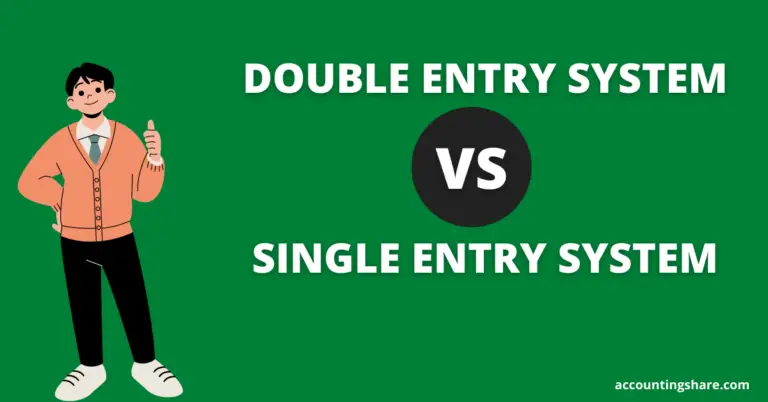Double Entry System-Definition, Example, Principles, Advantages and Disadvantages [With PDF]
This article will explain what a double entry system in accounting is and why it is so important.
You’ll also learn about the fundamental principles or characteristics of double-entry accounting, as well as the advantages and disadvantages of using it.
Read the entire article to find out how double-entry accounting works and much more.
So let’s get started.
What is a Double Entry System?
The double-entry system is the most scientific and reliable method of accounting. Every transaction in this system has a hint of a dual entity concept.
Every transaction has involved two or more accounts. These accounts are constructed using dual entity concepts. One is debit and the other one is credit.
The double-entry system records the transaction’s two parties, i.e., debit and credit, in separate accounts.
The same amount is written for both debit and credit in this method. As a result, the total amount of debit is always equal to the total amount of credit, regardless of the time of year.
The Double Entry System is the procedure for correctly recording dual entity transactions in order to prepare accounts correctly.
“Double entry book-keeping is a system by which every debit entry is balanced by an equal credit entry.
A Stephen
Simply put, a double-entry system is a bookkeeping system that is designed to record the two-fold aspect of a transaction, namely the debit and credit aspects, in such a way that total debits equal total credits.
Example of a Double-Entry System
Let’s look at an example to better understand the concept of a double-entry system:
Paid office rent of $5,000.
To record this transaction using the double-entry system, we must first identify the parties involved. It involves two parties or accounts:
- Rent Account
- Cash Account
Since rent is a business expense, it has been increased, and a rent of $5,000 will be debited. Again, cash is spent while rent is paid, so cash or assets are decreased, and the cash account is credited.
As a result, the same amount has been debited for both the rent and the cash account. This is the fundamental idea behind the double-entry system.
Brief History of the Double Entry Accounting System
The Double Entry System is well-established and well-known throughout the world as a dependable, scientific, and comprehensive system for keeping business accounts.
Accounting history shows that people in ancient times used to keep accounts by tying stones and ropes together. Their accounting methods were neither improved nor accurate.
Accounting is becoming increasingly important as people progress toward civilization.
Recognizing the significance of accounting, the most modern and groundbreaking theory was discovered in 1494 AD in Venice, Italy by the famous mathematical clergyman and philosopher Luka Pacioli.
He is called the father of accounting. His first book on accounting was “Summa de Arithmetica, Geometria, Proportianet Proportionalita”.
He discusses the double-entry accounting system in one chapter of this book. Since then, the double-entry accounting system has been used in accounting.
Fundamental Principles or Characteristics of the Double Entry System
The Double Entry System is the most dependable, scientific, comprehensive, and self-contained accounting system.
Each transaction measurable in terms of money or money’s worth is recorded in a two-fold aspect in a double-entry system, with one party being debited for receiving the benefit and the other being credited for ensuring the same.
The following are the principles or characteristics of the Double Entry System:
- Dual aspect:
One of the characteristics of a double-entry system is that each transaction must involve two parties. One is debit and the other is credit.
These two parties are referred to as the transaction’s duality. One party benefits from the transaction while the other party benefits equally.
- Giver and receiver:
Every transaction has a giver and a receiver by default. The giver pays for the benefit, and the receiver receives the same amount, i.e., the recipient’s account is debited, and the giver’s account is credited.
- Equal amount:
In a double-entry system, every transaction will have an equal amount of debit and credit.
- Results:
In a double-entry accounting system, the totality of debit and totality of credit are equal. It makes it simple to determine results.
- Classification:
In the double-entry accounting system, each account of each transaction in the business is classified separately.
That is, all events associated with a specific title are listed under that title. This produces a definite result.
- Scientific accounting system:
The double-entry system is the only scientific method of accounting in which the equation or mathematical formula for determining “debit” and “credit” is used to account for a transaction.
Transactions are then recorded in the books of account in accordance with accounting principles, concepts, and practices.
- Complete system:
The double entry system is a complete and scientific accounting system. This system ensures that the account is kept completely and that no party is overlooked.
In summary, these characteristics must be present in every transaction. If there is an exception, complete information will not be available in the accounting books. As a result, the primary goal of accounting will be thwarted.
Importance or Advantages of the Double Entry System
In the modern era, accounting is done using a double-entry system. This method of accounting is used by large business organizations. There are numerous benefits to keeping books under this system.
The following are the key benefits of the double-entry system:
- Complete Account
A complete accounting system is a double-entry accounting system. In this method, all accounting steps are shown in full at each stage of the accounting cycle, from transaction identification to financial report preparation, analysis, and interpretation.
- Providing arithmetical accuracy:
By keeping the account in this manner, the mathematical accuracy of the account can be verified using a trial balance, and if the two sides of the trial balance do not match, the necessary steps can be taken to determine the cause.
- Calculate the profit and loss:
Complete accounts of all types of transactions are recorded using this method, and after a certain period of time, the actual profit and loss of the business can be calculated by preparing a trading account and a profit-loss account using all types of nominal accounts.
- Determine the correct financial position:
All transactions relating to income, expense, liability, and assets are properly recorded in the account books using this accounting method.
After a certain period of time, i.e., at the end of the fiscal year, the financial report, which includes liabilities and assets, revenue income, and expenditures, is prepared, and accurate financial results are known.
- Calculate the amount owed and the debt:
All personal accounts can be properly saved using this method. As a result, personal accounts can be easily identified.
This means that the trader can easily determine how much money is owed to the debtor related to him and how much money is owed to the creditor using this method.
- Detection and prevention of errors and fraud:
Every transaction of the organization is recorded using this method by dividing it into two accounts, debit, and credit.
As a result, multiple sectors of the same account are impacted at the same time. As a result, the organization’s employees and officers are aware of the account manipulation.
As a result, account fraud, errors, and so on can be avoided.
- Beneficial for future planning:
The financial results determined by this method are also accurate because the double-entry system is a complete, scientific, and accurate accounting system.
Any future plans based on these results will be beneficial to the organization.
- International recognition:
The double-entry system is referred to as the “international accounting system” because the international accounting standards are fully adopted in accounting.
Since the adoption of international accounting standards, double-entry accounting has gained international recognition.
- Cost control:
A complete record of the expenditure transactions is kept because the accounts are maintained using a double-entry system.
This method takes into account all expenses incurred by the organization, so if actual expenses in any sector exceed estimates, the extra costs can be managed through comparative analysis.
- Report Availability:
If transactions are properly recorded using the double-entry system, the necessary statements or reports for cost accounting, management accounting, social accounting, and so on can be easily prepared.
- Determine the value of goods:
The double entry system records all types of transactions so that the production or selling price of the organization’s product can be easily determined.
This allows for the control of additional costs.
- An increase in profit:
A profitable sector can be identified by comparing the current year’s income or profit to the previous year’s income or profit, as the double-entry method keeps an accurate and complete account of each transaction. This can increase the company’s profit.
- To Determine Income Tax and VAT
In the double-entry system, all types of income and expenditure accounts are properly maintained so that income tax and VAT returns can be prepared and submitted to the tax authorities.
Value-added tax, on the other hand, can be easily assessed at the time of purchase and sale of goods.
- Information collection
Accurate data collection is critical for business planning and execution. The double-entry accounting system keeps accurate records of all types of business transactions.
So, if you keep the account in this manner, you can easily obtain accurate information.
Disadvantages or Limitations of Double Entry System
Accounting under a double-entry system may have disadvantages. These are discussed further below.
- The account system’s complexity:
Accounting rules and regulations, techniques, internationally recognized laws, and procedures must be followed in a double-entry system.
As a result, the same account must be recorded in more than one book in order to be kept in this manner. This can cause a number of complications with the accounting method.
- Need an experienced person:
Of course, an experienced accountant is required to keep accounts in this manner. Accounting knowledge, both theoretical and practical, is required of the responsible accountant.
Various errors will occur if the account is maintained by an inexperienced person.
- Increase in time, labor, and cost:
It is mandatory in a double-entry accounting system to keep separate books of accounts for the accounts by categorizing them according to the nature of the transaction.
Keeping these separate books requires additional time, manpower, and money, so the cost rises.
- Probability of error:
In the case of a double-entry system, the error is more likely to be due to systemic complexity and a lack of skilled personnel, as it is necessary to keep the books according to each accounting sector.
Despite the best efforts, it is often impossible to avoid such misconceptions.
- Increase the workload:
Many account books must be kept in this manner. Because the full details of each account cannot be recorded unless a separate book is kept.
As a result, storing different books according to account classification will increase the workload of the business organization.
- Application is limited:
The single-entry system is more commonly used in the case of a sole proprietorship than the double-entry system.
In other words, keeping accounts in a single entry system is more convenient than this method of keeping accounts for various small institutions, family deposit expenses, and cultural festivals. As a result, the field of application for this method is limited.
- A problem for less educated people
It is critical to have both theoretical and practical knowledge of accounting principles in order to preserve accounts in this manner.
It is not possible to keep accounts in this manner for those who do not have a thorough understanding of accounting principles. because it is a complex accounting system that requires proper knowledge.
- The difficulty in determining the dual aspect
According to the double-entry system, each transaction must be recorded in the ledger in two parts. Depending on the nature of the transaction, the beneficiary must receive debit and the beneficiary must give credit.
However, in many cases, determining which party will be debited and which party will be credited becomes complicated.
- The Problem of Secrecy
The workload is increased by storing many books of accounts in order to keep accounts in this manner. And for this work, a large number of people have to be recruited.
On the other hand, because a large number of people must be hired, protecting privacy is extremely difficult.
Finally, we can say that the benefits of a double-entry system outweigh the drawbacks. As a result, it is widely used in accounting.
You can also read:






Thanks for sharing, well explained.